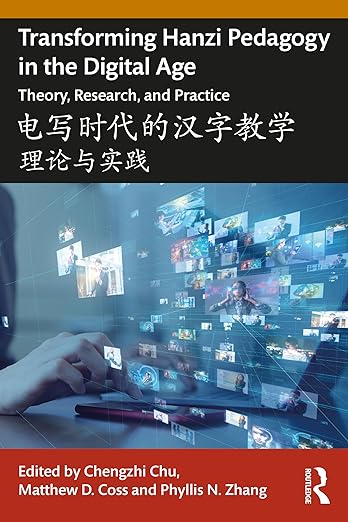I recently contributed the following reflection to a book called Transforming Hanzi Pedagogy in the Digital Age: Theory, Research, and Practice: 电写时代的汉字教学: 理论与实践 (1st Edition) by Chengzhi Chu (Editor), Matthew D. Coss (Editor), Phyllis N. Zhang (Editor).
With permission from the authors, I’d like to share my contribution to the book.
Reflections on Writing Chinese Characters In and Beyond School
by John Pasden
Writing as a Beginner
As a beginner learner of Chinese at the age of 20, I was extremely enthusiastic about learning Chinese characters. It was the artistic, cryptic of the Hanzi that pulled me in from the start, well before I was sure if I could ever possibly even make myself understood in spoken Chinese.
I loved the (rarely guessable) pictographic representations, the even more unintuitive characters indicating abstract meaning, and the plethora of combinations in a myriad of possible structures that very nearly descended into madness.
Of course I was eventually able to make sense of the system, but that would take years. If not for the undeniable allure of the written form, though, I never would have made it to that point.
Captivated by Calligraphy
As an undergraduate student at the University of Florida, I had a language partner from Zhuji (诸暨) in Zhejiang Province, China. This guy was a brilliant engineer, but was also a kung fu practitioner, competitive at the national level. When I asked him to write some characters for me one day during one of our conversation sessions, I never imagined what I was in for.
The strokes flew from his simple ballpoint pen like water… streams, rivulets, and splashes dancing across the page. He didn’t even tell me at the time, but he was also proficient in pen calligraphy. It blew my mind that these beautiful strokes were actually written language.
My passion for Chinese characters was ignited, but at the same time some seeds of doubt had been planted: there was no way I could ever write like that, right? What am I even doing?
Writing in Daily Life
A year later I wound up living in China. The year was 2000, and I soon came to understand that the average Chinese person does not write like a wizened philosopher-calligrapher.
Although I was writing out Chinese characters in my notebook, writing flashcards, and filling out the occasional form as part of daily life in Hangzhou, hand-writing characters was not a huge part of my life in China. Listening, speaking, and reading were my main interactions with the language.
What I found myself doing more was using a relatively new (at the time) chat program called QQ. I could chat in Chinese with random strangers, and because it was all in text and I used a Chinese name, they didn’t even realize they were chatting with a foreigner until I gave myself away. I made a game out of trying to delay the reveal as long as possible. If I could just get my grammar and vocabulary right (and you know I was furiously looking up words during every chat session), then I could sometimes do it.
Although Chinese characters had a special place in my heart, removing hand-writing from my practice of the language was actually liberating and heartening because I could spend more time on what I loved about the language.
Hand-writing for Academia
A few years later, I was working hard to get into a Master’s program in applied linguistics at East China Normal University (华东师范大学) in Shanghai. Although I had a background in linguistics, it wasn’t in Chinese linguistics, and it wasn’t in Chinese. So I had to pass a test on modern Chinese. The stuff I would have learned if I had done my undergraduate degree in China. But perhaps most significantly, the test was composed of a series of essays, to be written by hand, with a time limit.
Working my way through the Xiandai Hanyu undergraduate textbook was not bad at all. I enjoyed it. But I had to be able to answer a variety of questions in essay form. My characters couldn’t look too awkward, and my writing needed to at least approach the level of a Chinese university student. Perhaps what challenged me the most was increasing my speed. The muscle memory needed to be formed. It was a huge challenge, and I often found myself frustrated that I couldn’t spend more time on the fascinating linguistic features of Mandarin Chinese. I was jealous of my classmates, who could effortlessly produce eloquent sentences in beautiful semi-cursive script. I knew my academic Chinese was improving rapidly, but when I watched them write, I felt pangs of despair. I had to repeatedly remind myself what I already knew: that hand-writing was not crucial to my learning.
The Death of Hand-writing (for Me)
I got into the Master’s program. Eager to learn and to prove myself as the only foreign student in my class, I was ready every lesson to take notes on my professors’ lectures. There were a lot of lectures. They were long. They were sometimes rambling. Before long, I started wondering how many notes I really needed to take. And I noticed that some of my classmates were bringing their laptops to class.
By the second semester, I was digital only. It was so much easier to type out any notes I needed to take. More importantly, after being admitted into the Master’s program, I never needed to write by hand again. In the work I started doing in my field, I never needed to write by hand either. This was a trend that would extend to all aspects of my life in China.
What’s more, I had proved to myself that I could do it: I could get my hand-writing speed and proficiency to the point that I could pass written exams. But I would probably never again take such a written exam. Knowing I could do it was enough for me. The challenge had been met, and I was ready to move on.
Breaking the Cycle?
I’m now an educator helping learners of all levels to learn Chinese. The subject of characters and hand-writing comes up often. Usually the solution is simple: in this day and age, it’s no longer necessary to learn to write everything by hand. Sure, there are exceptions… if you want to become a Chinese calligrapher, your fate is quite different! But most learners nowadays want to read electronic texts in Chinese and send messages to Chinese friends on WeChat, by email, or in other digital spaces.
And yet, some learners have trouble remembering characters at all without considerable time invested differentiating similar characters, researching character etymologies, or, in some cases, even writing out lots of characters like the students of yesteryear.
Furthermore, my own children have grown up in China, and I see no sign of the rote method for learning characters changing any time soon. Even in the midst of the Shanghai government’s “Double Reduction” (双减) policy, and the online schooling forced upon us by the pandemic, the demand for extensive hand-writing continues.
I can’t help but wonder: can we learners ever be truly free of this burden when native speakers are not? Is a better solution already here in this digital age if we could just shake off the shackles of tradition? Although the temptation is strong to teach beginner foreign learners in the same rote ways that Chinese children have learned traditionally, new research is promising. Personally, I am optimistic.
Additional Links
If you are an educator or learner interested in this book, you can purchase it on Amazon: Transforming Hanzi Pedagogy in the Digital Age: Theory, Research, and Practice: 电写时代的汉字教学: 理论与实践 (1st Edition). I truly believe that this is the future of Chinese learning, and it’s great to see this group of educators pushing forward with the idea of typing as primary over hand-writing character.
Olle Linge, writer of the blog Hacking Chinese, was another contributor to this book. He has posted his own contribution here: Chinese character learning for all students.
This summer at AllSet Learning my team and I have finally made public a very long-term project in the form of a book called Learn Chinese Characters by Reading. It provides a method and a sequence for learning to read the 200 essential characters which will put you on the road to reading Chinese. It is very much in the spirit of the book I’ve quoted from above, and one of the researchers, Matt Coss, has written the foreword which you can read online. (I’ll be writing more about this book soon.)
The post Reflections on my Experience Learning to Write Chinese Characters appeared first on Sinosplice.


